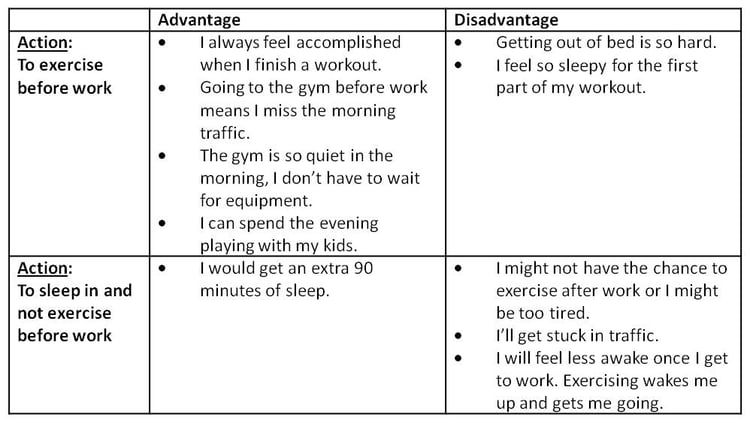Part 2 of this blog series focused on the importance of scheduling time to exercise and practice healthy eating. This scheduling involves setting aside time not only to exercise but also to prepare healthy meals. I also stressed how important it is to stick to the schedule as often as humanly possible.
But what do you do if you are simply dreading exercise? Or if you are dying to take a nap on Sunday afternoon instead of doing meal prep?
TIP: Write Out the Advantages and Disadvantages of Taking a Healthy Action
Contemplating the advantages and disadvantages of a decision is a cognitive-behavioral therapy technique that serves as a great reminder of why you were motivated to make healthy changes in the first place. The following represents an advantage/disadvantage square. In my experience, people who fill these out often decide to make positive, healthy choices. And with practice, you can easily do these in your head!

As you can see, the advantages of exercising before work far outweigh the disadvantages. Sometimes, simple reminders like this are all you need to feel a bit more motivated. And if you happen to have a day where your disadvantages are greater than the advantages, this is a sign that you may need to take the day off to focus on other things (which is okay…it happens to EVERYONE).
The Bottom Line
You have the power to influence your motivation levels, so don’t wait until you feel motivated to make a positive change.


 In
In  That’s right, it’s okay to feel unmotivated! After all, it’s a natural feeling that extends to many aspects of our lives. How many of us really feel motivated to fold that last load of laundry? Or make our beds in the morning? Or write that last report of the month? At some point, we all struggle with motivation.
That’s right, it’s okay to feel unmotivated! After all, it’s a natural feeling that extends to many aspects of our lives. How many of us really feel motivated to fold that last load of laundry? Or make our beds in the morning? Or write that last report of the month? At some point, we all struggle with motivation.
 Six months ago, a friend dared me to give up cardio for three months and focus on strength training. My initial response was, “No way! I’m a runner, I’ve always been a runner. There is no better exercise than running!” My friend was relentless and eventually I agreed to take a brief hiatus, although I was convinced that I would turn into a mushy ball of goo if I didn’t get in my daily run.
Six months ago, a friend dared me to give up cardio for three months and focus on strength training. My initial response was, “No way! I’m a runner, I’ve always been a runner. There is no better exercise than running!” My friend was relentless and eventually I agreed to take a brief hiatus, although I was convinced that I would turn into a mushy ball of goo if I didn’t get in my daily run. 
 The other day I went out to dinner at a restaurant to celebrate a friend’s recent work promotion. Being a health-conscious person, I ordered grilled chicken and a salad with a small glass of wine. As I handed my menu to the waiter, my friends commented about how I didn’t “need a salad” and that I should “eat what I want” because I exercise enough.
The other day I went out to dinner at a restaurant to celebrate a friend’s recent work promotion. Being a health-conscious person, I ordered grilled chicken and a salad with a small glass of wine. As I handed my menu to the waiter, my friends commented about how I didn’t “need a salad” and that I should “eat what I want” because I exercise enough. 